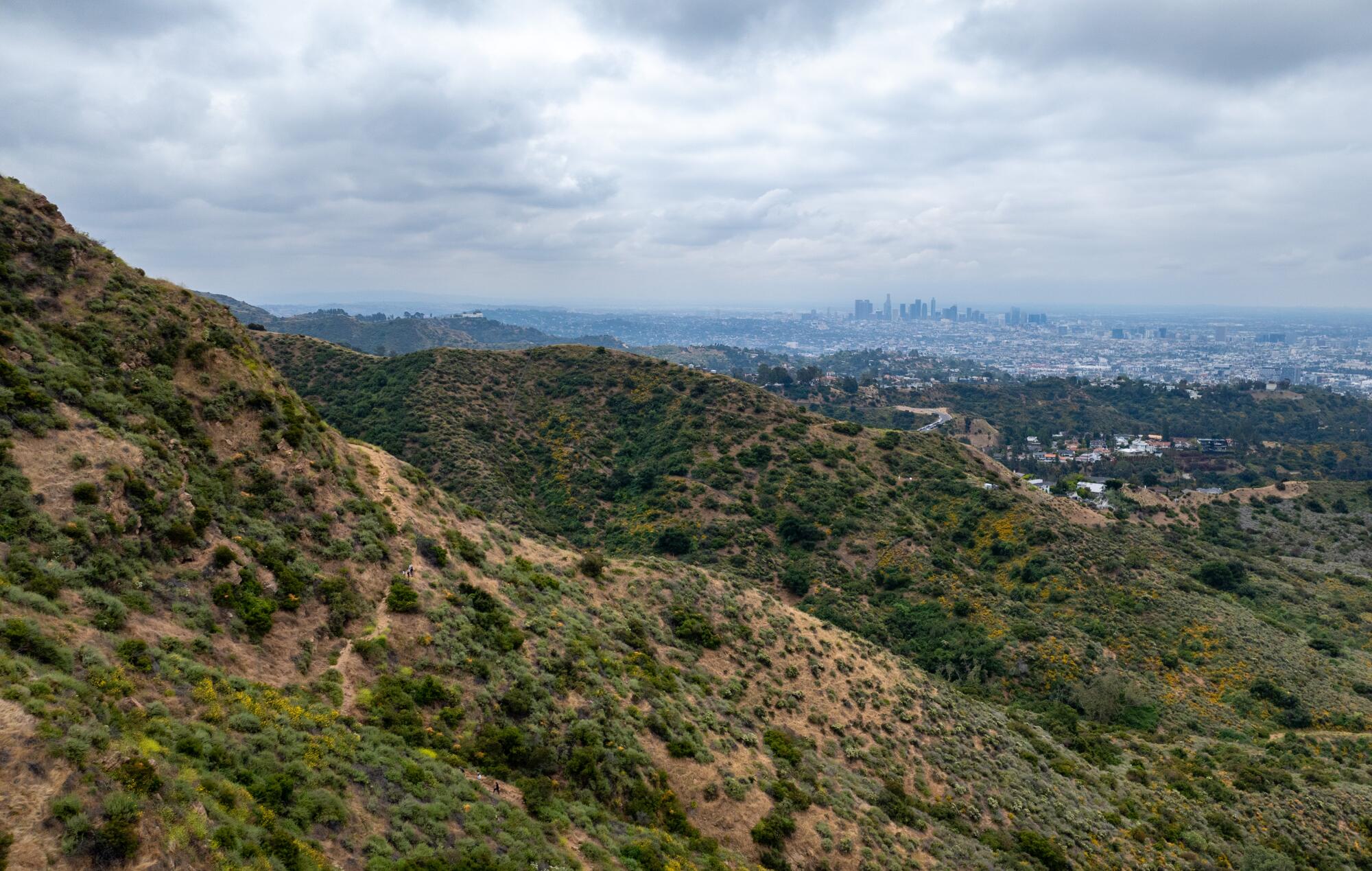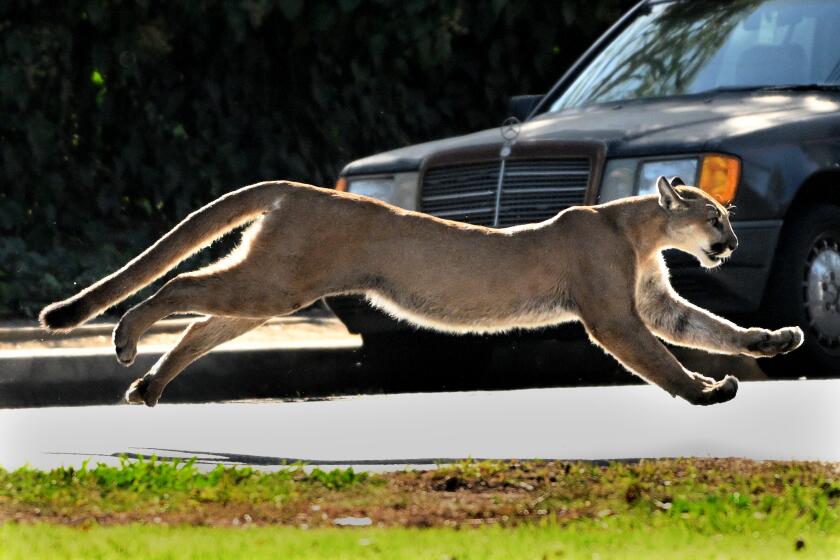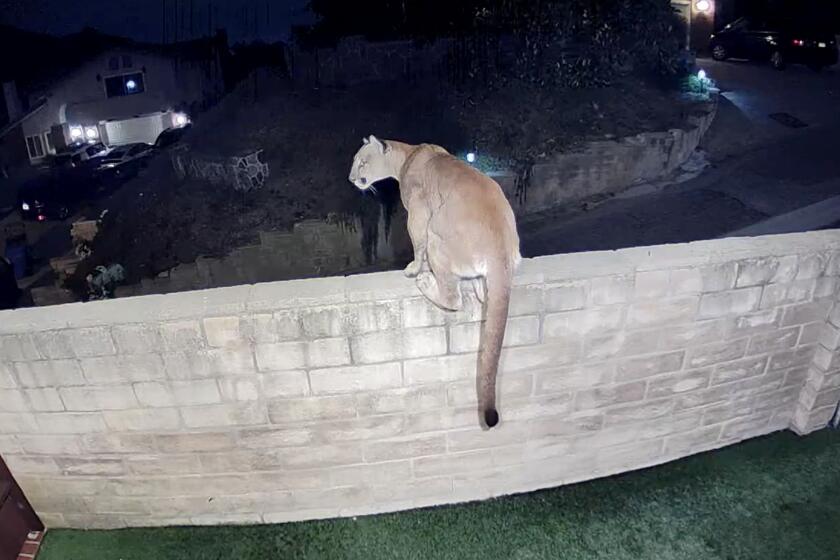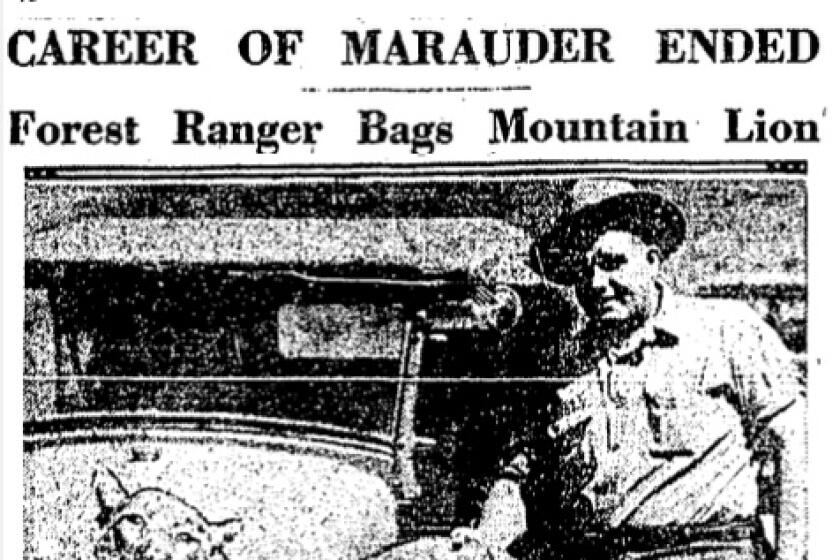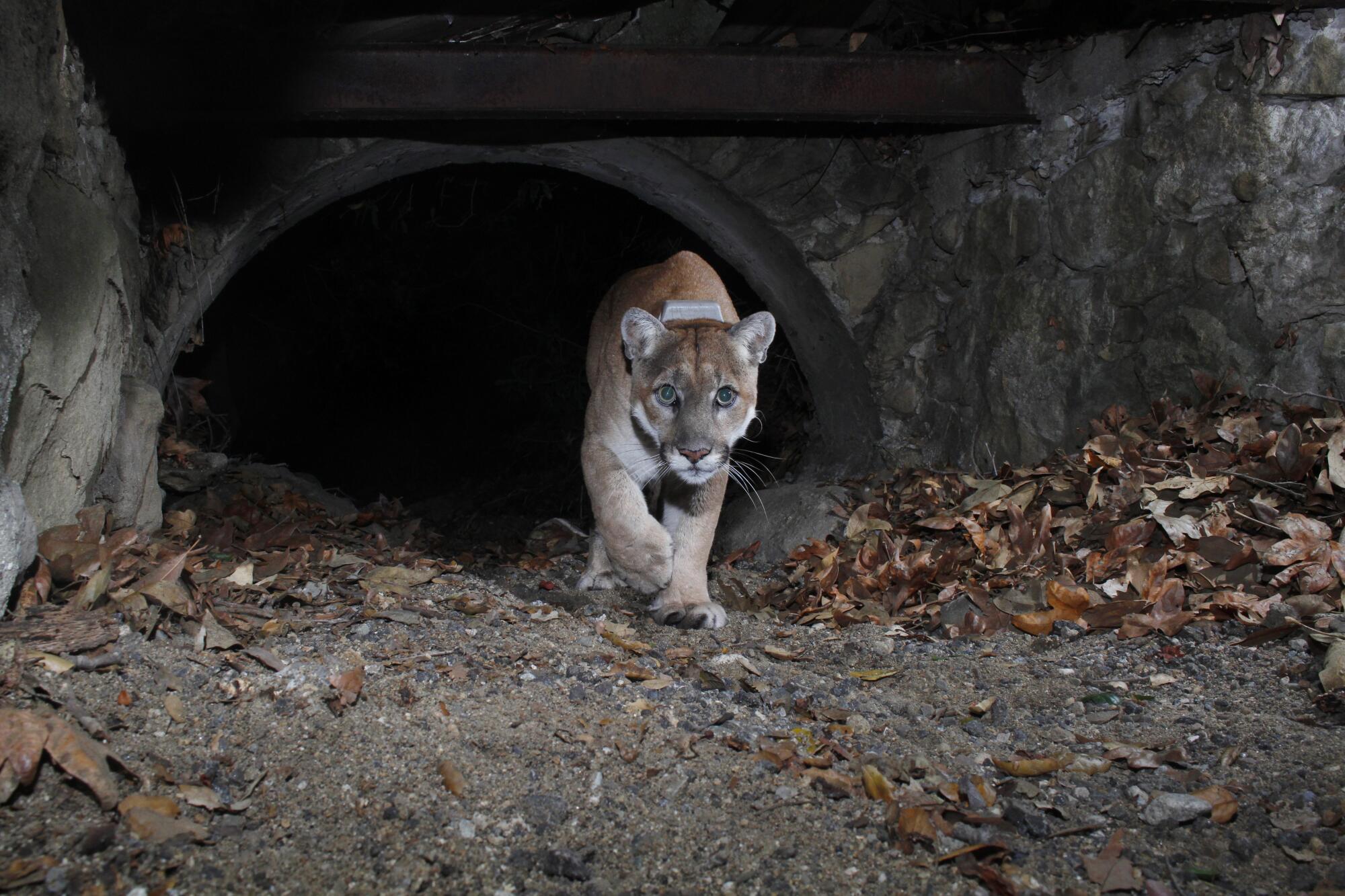
- Share via
A sleek mountain lion filmed from behind the wheel of a Tesla on the edge of Griffith Park last month triggered a collective double take in Los Angeles.
Not long ago, the park’s long-reigning king — the cougar known as P-22 — stalked the same hills.
While P-22’s stint in Hollywood brought him fame and devotion — landing him on T-shirts and culminating in a sold-out memorial — it also came with deadly trappings inherent to his urban-adjacent environment. Rat poison and car collisions battered him from the inside out. He was captured and euthanized in late 2022, deemed too sick to return to the wild because of injuries and infection.
A mountain lion living in Griffith Park today would likely suffer a similar fate.
Aggressive and impactful reporting on climate change, the environment, health and science.
“Has anything changed, in some respects, in Griffith Park? No,” said Beth Pratt of the National Wildlife Federation, a vocal booster for Southern California mountain lions, P-22 in particular. “As much as people are really excited about this cat, a lot, including myself, are worried about him.”
Cars still whiz along freeways that isolate small populations of lions and perilously limit genetic diversity. Some types of rat poison, which travels up the food chain to an apex predator like a puma, can still be bought at the hardware store.
But P-22’s high-profile plight highlighted the challenges and helped inspire efforts to make the region a safer place to be a mountain lion — even if change hasn’t caught up to the heartbreaking reality.
What’s billed as the largest wildlife crossing in the world — with a staggering price tag to match — is taking shape over a stretch of the 101 Freeway in Agoura Hills. A pair of bills that recently cleared the California Assembly would expand a ban on certain rodenticides and require cities to consider wildlife connectivity in planning documents.
P-22 “did spur us to action,” Pratt said.
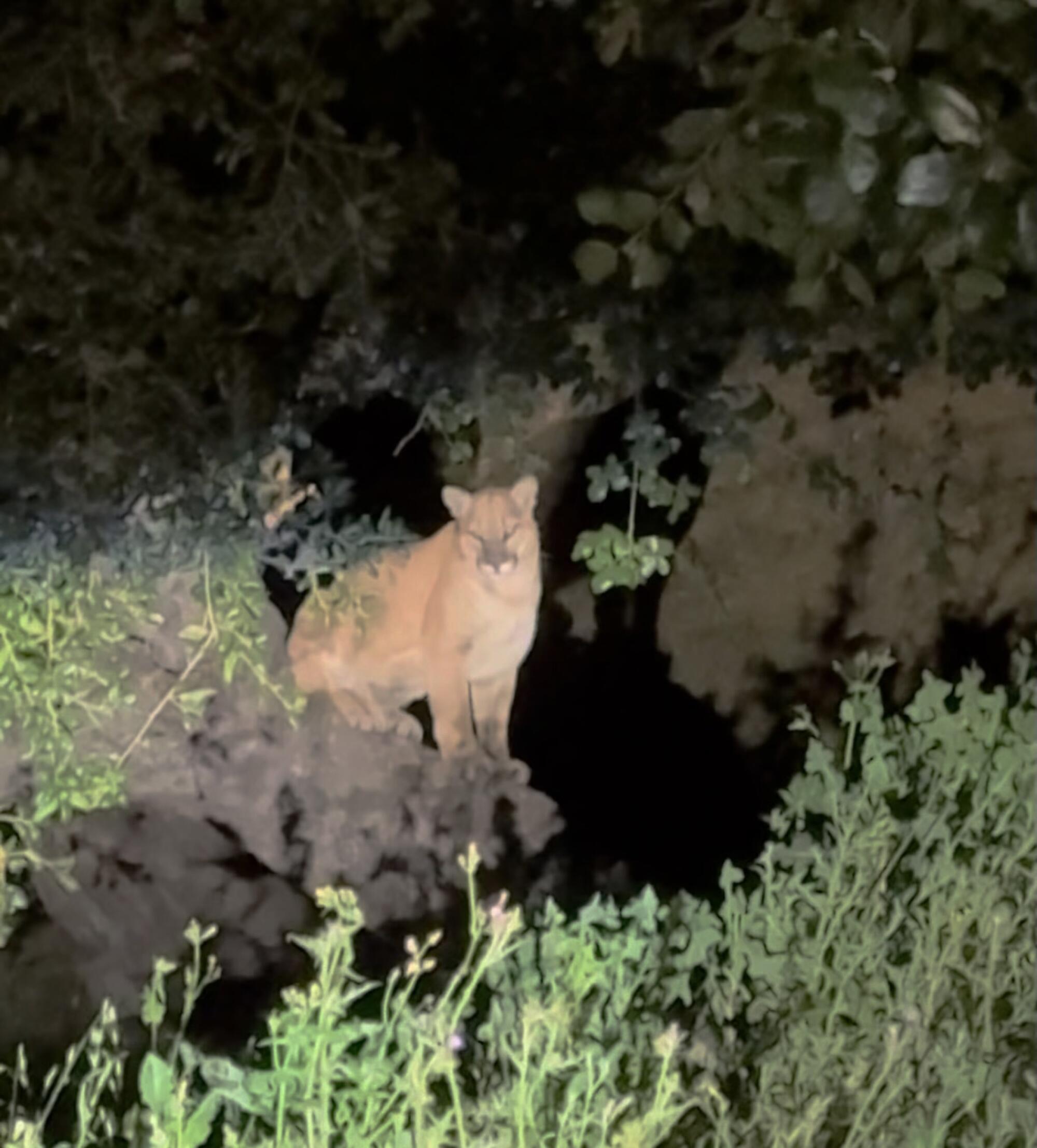
Very little is known about the lion spotted in mid-May in a parking lot east of Barham Boulevard on the edge of roughly 4,200-acre Griffith Park.
Vladimir Polumiskov captured video of the majestic creature on his phone after he and his wife and young son returned to their Hollywood Hills apartment after a weeknight dinner out. Headlights from Polumiskov’s car illuminate the cat’s sand-colored fur as he perches on a tree.
Researchers who have seen the video believe it’s a young-leaning male lion. He’s not wearing a collar and therefore not part of the National Park Service’s 22-year study of mountain lions in and around the Santa Monica Mountains, of which Griffith Park marks the easternmost end.
Scientists involved with the study are trying to find him — scouting primarily via remote cameras — so they can add him, said Seth Riley, a wildlife ecologist with NPS. If he’s captured and collared, scientists will be able to track his movements and analyze his DNA to see if he’s related to other lions in their database.
Typically, young male mountain lions disperse, often traveling long distances to search for mates and a suitable home to call their own. That’s probably what P-22 was after — though he ended up in an abnormally small area for his species, and one believed to be lacking in lady lions. Experts didn’t expect him to stay long, but he hunkered down for 10 years.
Scientists have completed the first comprehensive estimate of mountain lions in California, a vital statistic needed to shape puma-friendly land-use decisions and ensure that the predators can find room to roam, mate and find prey.
Griffith Park, surrounded on all sides by perilous freeways and roads, isn’t an easy place for a lion to get to — or leave.
Pratt said the recently sighted lion probably hails from the Santa Monica Mountains and took the same harrowing trek as P-22, who presumably traversed the 405 and 101 freeways. But it remains speculation in the absence of a genetic workup.
There’s no telling whether he’ll stick around.
There are some upsides to the park. Namely, plenty of deer and no other adult male mountain lions, which chase and sometimes even fight young lions to the death.
“He might not be in Griffith Park anymore,” said Pratt, California regional executive director for the NWF. “Or he could be settling in and claiming this for his new home.”
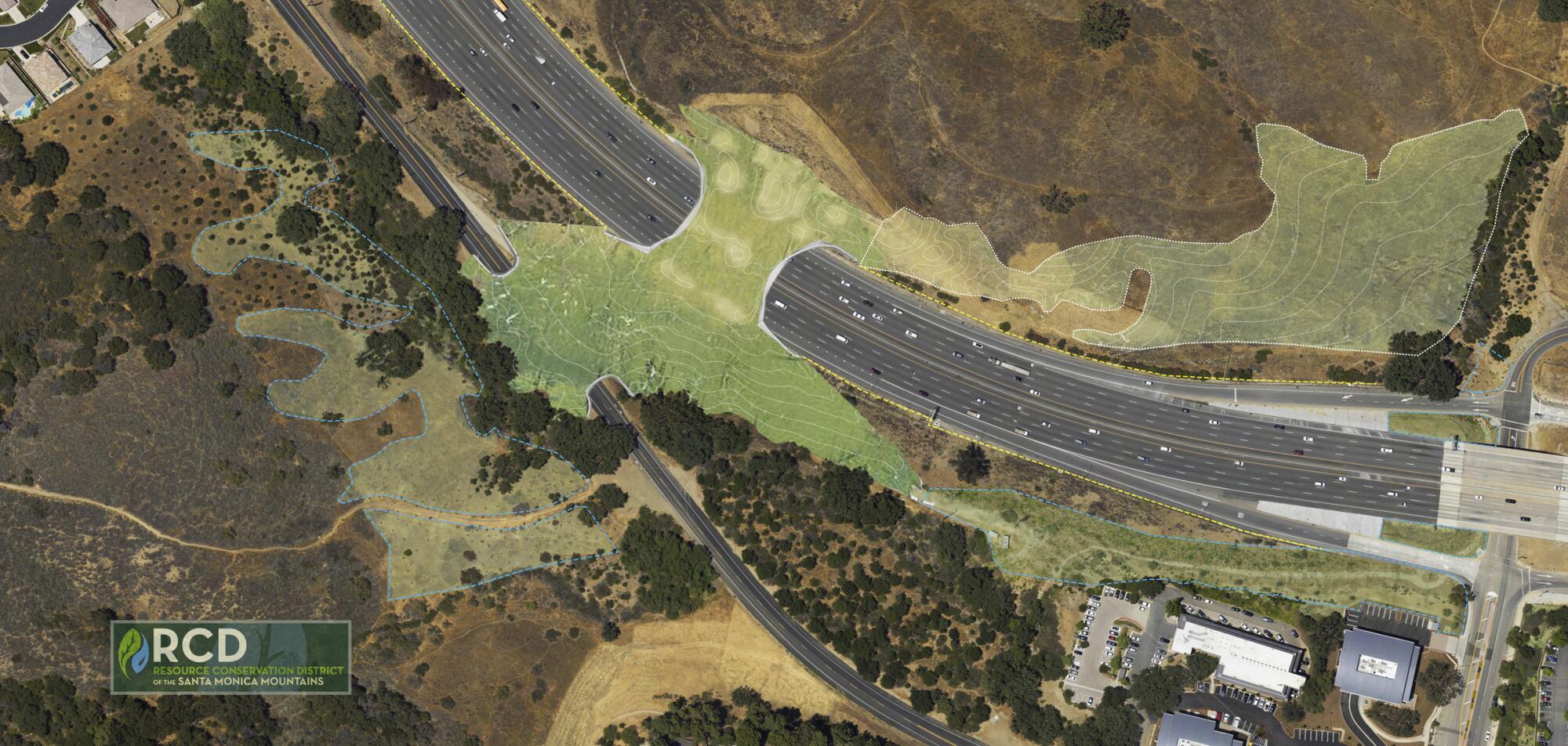
Last month, Pratt scrawled “For P-22” onto the final girder placed onto the Wallis Annenberg Wildlife Crossing, a construction milestone that completed the bridge’s foundation. Numerous others honored P-22 in their own signatures, she said.
Those who want to see Southland lions succeed point to the $92-million crossing as holding perhaps the biggest promise. If the crossing had been built when P-22 was looking to settle down, he might have been able to cross it and go north to “mountain lion paradise,” Los Padres National Forest, Pratt surmised.
The 101 Freeway functions as an “impenetrable wall,” Pratt said. Lions to the south can’t get out and lions to the north can’t get in, forcing isolation and inbreeding. Birth defects, including kinked tails and deformed testicles, have already shown up in the small population sequestered in the Santa Monica Mountains. Next is likely sterility, Pratt said. A recent study found they could face extirpation within 50 years without intervention.
An Agoura Hills couple saw an unexpected visitor when they peeped at Ring camera video, a sleek, untagged mountain lion.
Based on what researchers have learned, “this crossing will really be helpful for animals to leave the Santa Monicas, but also it’s kind of even more important, from a genetic point of view, that animals are able to come into the Santa Monicas,” said Riley, who is the branch chief for wildlife at the Santa Monica Mountains National Recreation Area and an adjunct professor at UCLA.
“Because we’ve documented low genetic diversity in the Santa Monicas, and we’ve documented a bunch of cases of close inbreeding, where fathers are mating with daughters and close relatives are breeding.”
The crossing is slated to open in 2026. And there’s a lot of work to be done before that to get it ready for animals on the move.
Pratt said they’re currently working on the structure looming over a 10-lane stretch of freeway. Soon they’ll lay down two big slabs of concrete, and by the end of the year soil and plants will be added. Next spring, they expect to begin working on the portion over Agoura Road.

Meanwhile, two bills that advanced out of the state Assembly last month aim to tackle mountain lions’ top challenges: cars, connectivity and rat poison. The bills, both introduced by Assemblymember Laura Friedman (D-Glendale), need to pass the Senate by Aug. 31 to land on the governor’s desk for final approval.
Vehicle strikes are the top killers of mountain lions studied by the National Park Service. Rodenticides are tied for second with fights with other animals.
P-22 was struck by a car toward the end of his life a few blocks south of Griffith Park and a subsequent exam revealed an old injury that may have been caused by another collision. He was also exposed to rat poison and developed mange.
Assembly Bill 1889, called the Room to Roam Act, would require local governments to consider and implement measures to protect wildlife connectivity as part of their general plan.
That could entail installing wildlife-friendly fencing or lighting or identifying and protecting a corridor known to be used by animals. (It does not require crossings to be built or land to be set aside.)
The bill directs cities and counties to plan development in ways that don’t unnecessarily impact the movement of wildlife, said J.P. Rose, urban wildlands policy director at the Center for Biological Diversity, which sponsored the bill.
Connectivity isn’t often considered until a specific development reaches the proposal stage, Rose said, which “misses a key opportunity to take a regional look at the issue of wildlife connectivity. And because it is a regional issue, the best place to look at it is in these kind of longer-term, broader plans.”
The bill arrives about two years after the passage of a law that directed the California Department of Transportation to explore wildlife connectivity when it builds or expands roadways. The Room to Roam bill addresses the “other side of the coin,” Rose said.
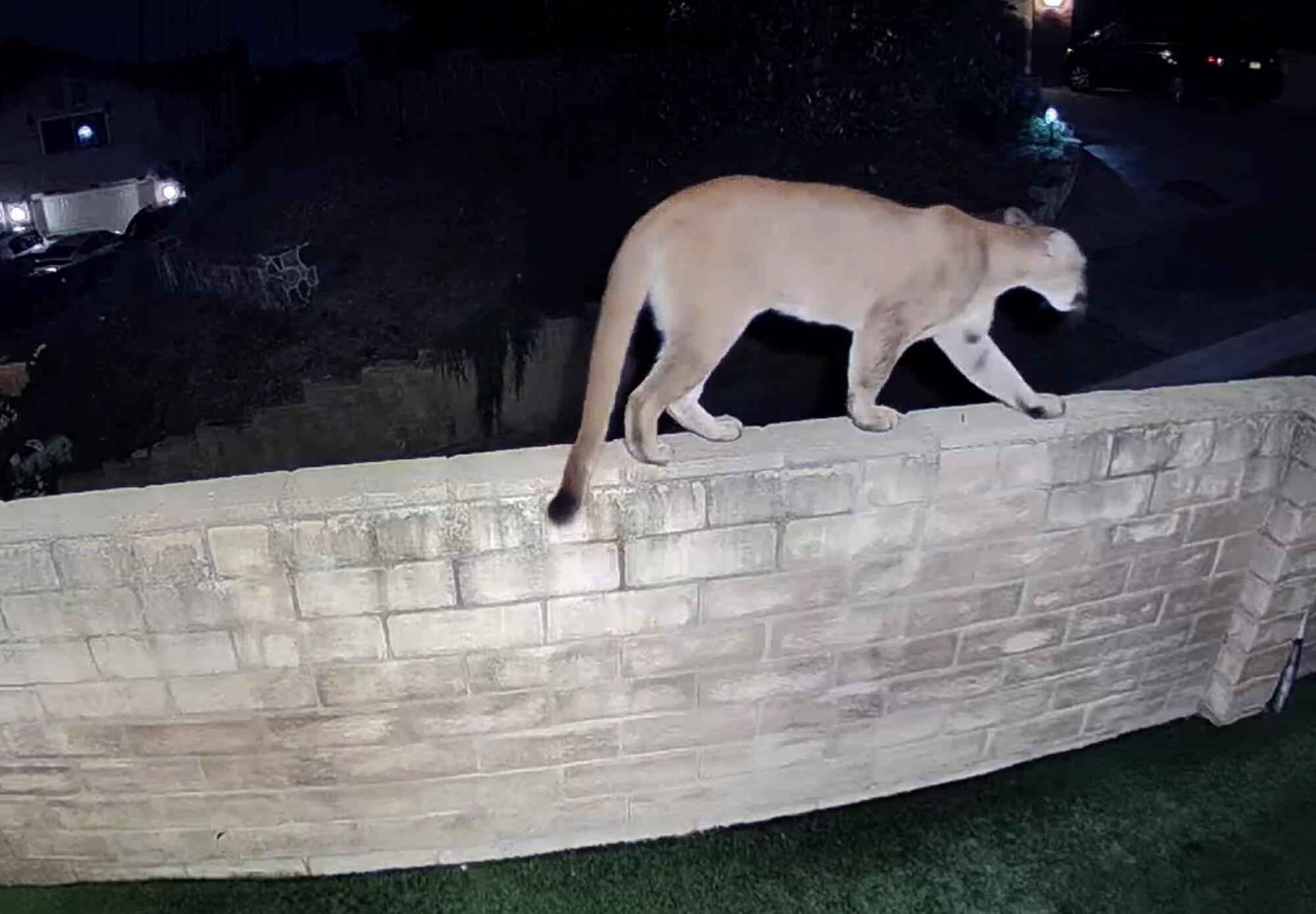
Though previous laws have limited the use of certain rat poisons, others remain widely available. Assembly Bill 2552 would place restrictions on additional types, including removing them for over-the-counter purchase and limiting their use in wildlife areas.
“This bill is an attempt to get some of those off the shelves so that people aren’t going to Home Depot and buying these super toxic rodenticides and unknowingly poisoning wildlife,” said Rose of the bill, also sponsored by the center.
The poisons being targeted — chlorophacinone and warfarin — are known as first-generation anticoagulant rodenticides. They stop a rat’s blood from coagulating and stay in the animal’s system after it dies. When an unsuspecting mountain lion or owl gobbles a dead or sick rat — or another animal that ate a tainted rat — the toxic substance is passed on.
The state was essentially at war with cougars until the 1960s, when the bounties ended. As the big cats’ numbers declined, they came to enjoy more and more protections.
Rose called the impacts “really heartbreaking.” He said poisoned predators don’t always die right away; sometimes they “slowly bleed to death from the inside.” The poisons can cause skin diseases and lead to organ failure and a depressed immune system, which might prevent animals from being able to find food or shelter in their sickened state — another pathway to death, he said.
Riley, of the National Park Service, said researchers are “still continuing to get exposure in basically every animal we test.”
His team believes it’s likely that the mountain lions they study are ingesting the poison when they eat carnivores — particularly coyotes, their second-most commonly consumed prey after deer. Often cougars go straight for their nutrient-rich organs, including the liver, where the compounds are stored.
There’s general consensus that these efforts are part of a long game. No single crossing or law will be enough to make Southern California a safe place for mountain lions (or other wildlife). The goal is to continue building out connectivity while detoxifying the landscape — and make environmental and development decisions with the cats in mind going forward.
Big cat supporters are already scheming about where to place future crossings.
National Park Service researchers are conducting a connectivity study along a portion of the 101 Freeway at the western end of the Santa Monica Mountains known as the Conejo Grade. It’s an area with undeveloped land on both sides, Riley said. Recently, there were renewed calls for crossings north of San Diego County, where the 15 Freeway strands another population of genetically isolated lions. There have also been informal talks about where crossings could be installed in or near Griffith Park, according to Pratt. The Cahuenga Pass, where P-22 is believed to have crossed, is on their radar.
If all goes well, P-22 might be the last of his kind.
“If, in the long run, all of these areas were better connected, then animals, hopefully, in the future, won’t end up stuck in Griffith Park like P-22,” Riley said.
